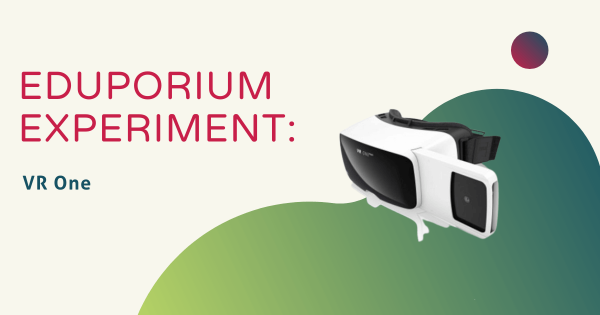The meeperBOT is a portable, mobile and intuitive robot that kids can use to learn the basic concepts of programming and robotic behavior. With the meeperBOTS app, students as young as five years old, can control the meeperBOT with a simple, handheld, on-screen remote. Head inside to learn more about it.
Eduporium Experiment
Our Eduporium Experiment series is one of our longest running blogs. Whenever we add new STEAM solutions to our store, we try it out so we can learn all about it. Over the years, we've covered dozens of top STEAM teaching tools, offering our first-hand insights and tidbits for educators. We believe this content gives K–12 teachers valuable information when it comes to using various STEAM solutions with their students. Our team analyzes products from different points of view and even considers implementation strategies in different educational environments. Whether it's most useful in the makerspace, library, or in the general classroom, we're happy to continue providing these helpful guides. You'll even find classroom-ready STEAM projects to try with your students. Browse through the posts or use the search bar on the left to find exactly what you're looking for.
In each 'experiment,' we provide key background information on the STEAM tool being featured. From there, we explore an actual project. This allows us to discover subtle tricks and hints that are extremely helpful for educators to know. Whether it's a coding tool, educational robotics solution, or even an engineering kit, we do our best to cover everything educators are investigating. As the Eduporium Experiment series has expanded, we've come a pretty long way. Now, you can find dozens of helpful articles that may include step-by-step project guides, troubleshooting suggestions, and even our thoughts on what makes each STEAM tool worthwhile for 21st century students. Find our insights on integrating STEM tools like the Bee–Bot, Finch 2.0, Ozobot Evo, micro:bit V2, and so many more!
-
Eduporium Experiment | littleBits Space Kit
The littleBits Space Kit, developed in collaboration with NASA, brings an aspect of interactive exploration to problem-based learning. Designed for use in junior high and high school, the Space Kit is one of the more advanced kits in the littleBits progression, but definitely one of the most exciting to use! -
Eduporium Experiment | DIY Synth Kit
Want to make the next big hit? Kits can do that with ease using the DIY Synth Kit from Technology Will Save Us! With the Synth Kit, students 12 and up can design and build a real musical instrument and tinker to create awesome electronic sounds. The kit lets them plug various components into the breadboard and experiment with creating -
Eduporium Experiment | Circuit Stickers
Let’s blend art and light technology with Circuit Stickers! Circuit stickers are LED circuits in the form of peel-and-stick stickers. They enable students to build real circuits without soldering, plugging wires, or clips. Instead, students use the stickers and conductive tapes to draw their circuits on paper, adding an intriguing element to their crafts. -
Eduporium Experiment | littleBits Gizmos & Gadgets Kit
Want to build your own Top Secret Spy Box? Bubble-blowing bot? If you answered yes, then you need to get your hands on the littleBits Gizmos and Gadgets Kit! Designed for kids 8 and up and filled to the brim with LEGO-like, electronic building blocks, this kit will spark your child’s imagination and guarantee endless opportunities for inventing. -
Eduporium Experiment | The DIY Electro Dough Kit
With the DIY Electro Dough Kit from Technology Will Save Us, children can build craft projects, and add electric elements. Picture being able to shape and create whatever your imagination desires and then really bring it to life by incorporating simplistic, interactive circuits. The Electro Dough Kit helps kids will learn how to place LEDs and buzzers in the path -
Eduporium Experiment | Circuit Scribe
Kids can draw circuits instantly and learn the basics of electronic principles with this no-mess conductive ink pen. I experimented with the Circuit Scribe Lite Kit, which comes with one conductive ink pen, two coin cell batteries and one Bi-LED module. The kit includes components like, motors, buzzers, resistors, and more. -
Eduporium Experiment | Cubelets Robots
If you are looking to introduce robotics at a young age, Cubelets is a fantastic way to do so. The three easy-to-use robot construction kits each come packaged with simple instructions along with some increasingly complex robot project ideas. I experimented with the Cubelets Six Kit, which includes six unique blocks. -
Eduporium Experiment | Teenage Engineering PO-12
The Pocket Operator (PO) comes pre-installed with a default beat, which kids can edit, change and add sounds to. That was great for me because I’m not exactly well-versed in the world of musical composition. Like many of today’s top EdTech tools, it was super easy to use the PO-12 and it really made the music creating process simple but -
Eduporium Experiment | VR One Headset
Virtual reality is all the rage these days and is definitely primed to become a huge part of our lives, but is usually still really expensive to acquire some of the equipment needed to optimize the experience. The VR One headset, however, is a cheap alternative that embodies a lot of the educational uses of VR—and teachers can distribute it













